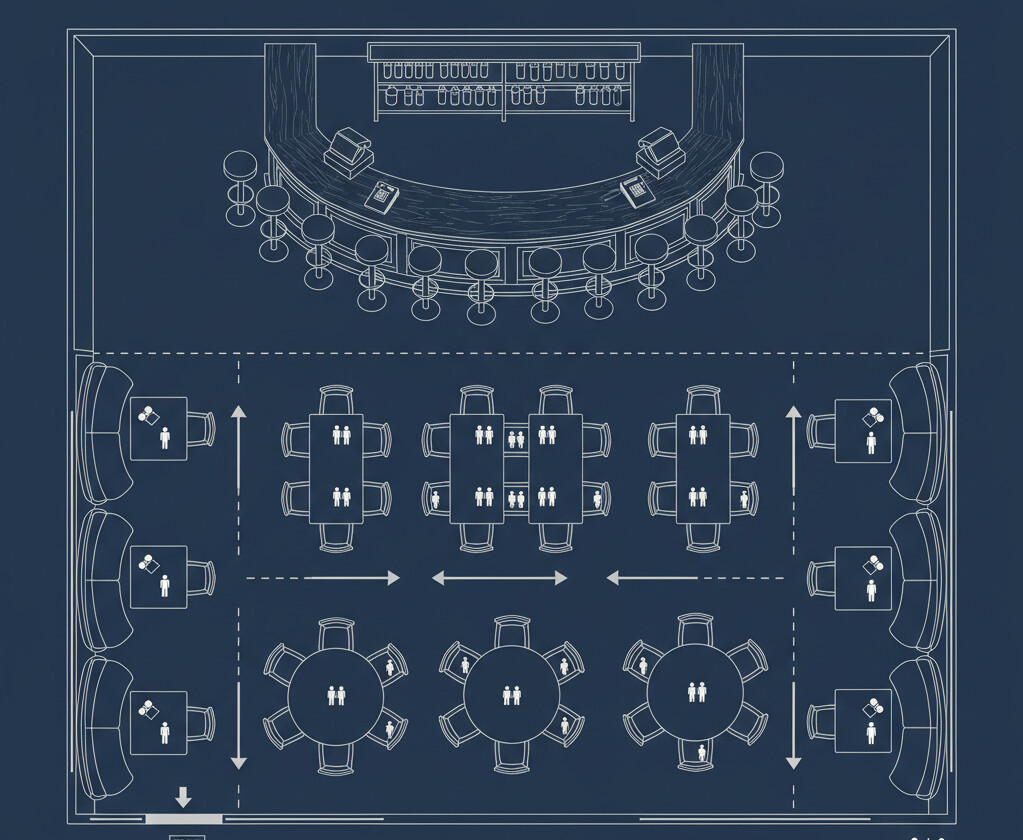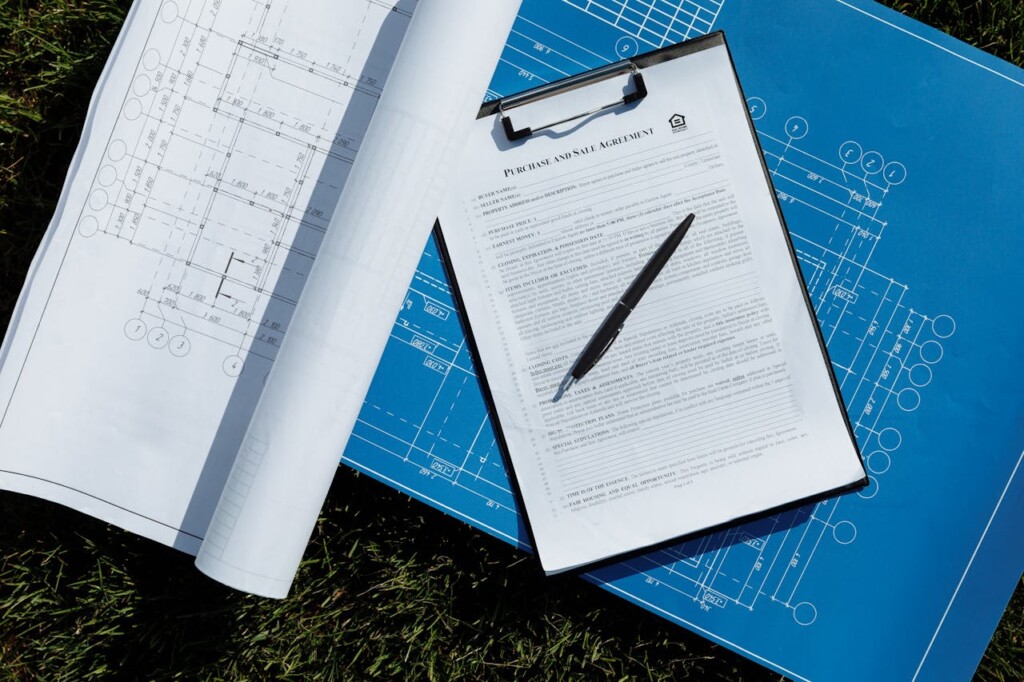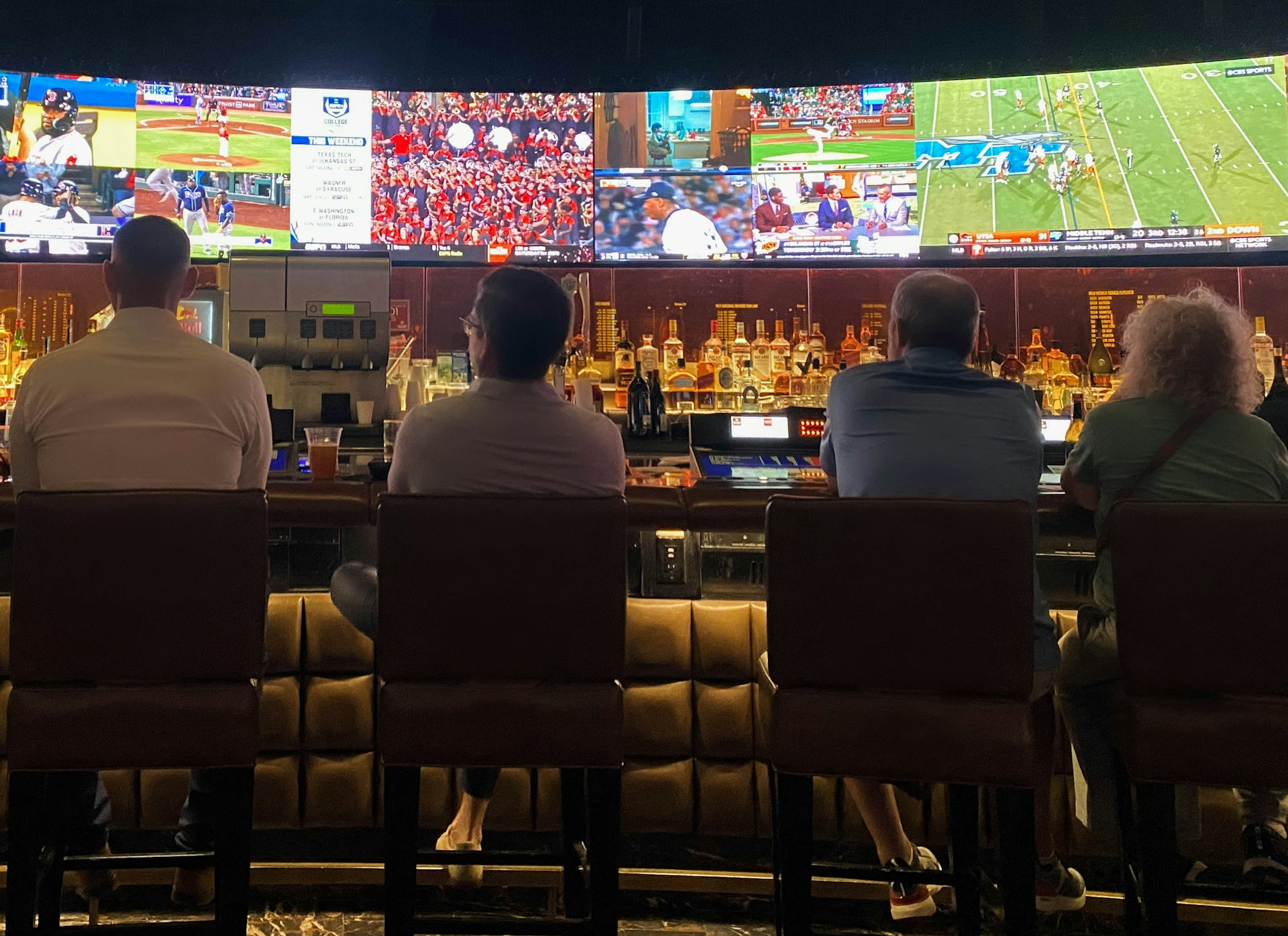Ensuring a safe and comfortable environment for your patrons is fundamental to running a successful restaurant. In Fort Worth, this principle is formally established through a restaurant occupancy load calculation, a critical safety measure that determines the maximum number of people your dining space can legally and safely accommodate at one time.
This code-based calculation determines maximum occupancy limits based on your space’s size and intended use. Fort Worth uses International Building Code standards through local Development Services processes, where inspectors evaluate exits, fire safety systems, and accessibility features before issuing your Certificate of Occupancy with the final occupancy number that legally governs your operations.
How Do You Calculate Occupant Load For Dining, Bar, And Waiting Areas?

Calculating occupant load for restaurant spaces requires selecting the right factor based on how guests actually use each area. The calculation method divides the space by specific factors established through International Building Code guidelines and practical observations of human movement patterns.
Standard Occupant Load Factors For Restaurant Areas
Different restaurant zones require different calculation factors based on guest behavior and space usage. Table and chair seating areas use 15 square feet per person, reflecting the space needed for diners, their chairs, and service access. Chair-only seating or standing areas like dance floors require 7 square feet per person, allowing for closer proximity without table service needs.
Waiting and queuing areas calculate at 5 square feet per person, the most concentrated factor for restaurant spaces. This factor accounts for guests standing in lobby areas, waiting for tables, or forming lines at host stations. These calculations come from occupant load factors referenced in Table 1004.5 of the International Building Code, which establishes minimum space requirements for different assembly functions.
Using Net Floor Area For Calculations
Restaurant occupant load calculations use net floor area rather than gross measurements. Net floor area excludes spaces where guests do not normally congregate, such as restrooms, stairways, mechanical rooms, storage areas, and back-of-house kitchen spaces. We measure only the areas guests can actually occupy during normal operations.
This approach provides more accurate load calculations because it focuses on spaces that genuinely accommodate people. Gross floor area would include non-occupiable spaces, artificially inflating the calculated occupancy and potentially creating unsafe conditions during emergency egress situations.
Fixed Seating Calculations
Fixed seating requires direct counting rather than area-based calculations. Restaurant booths calculate at one person per 24 inches of booth length, measured from the backrest. This factor accounts for the additional space diners need while seated and eating at fixed tables.
Benches and pews calculate at one person per 18 inches of length, while individual seats with defined boundaries count as one person per seat. Fixed seating provides more predictable occupancy numbers since the seating arrangement cannot be modified by staff or guests during operations.
Mixed-Use Zone Calculations
Most restaurants contain multiple use areas requiring separate calculations for each zone. We calculate dining rooms, bar areas, waiting spaces, and any entertainment areas independently, then add the totals together. A sports bar might have booth seating at 15 square feet per person, standing bar areas at 7 square feet per person, and a waiting area at 5 square feet per person.
Each zone calculation uses its net floor area and appropriate factor. The final occupant load combines all zones to establish the total building capacity. This zone-by-zone approach ensures accurate calculations that reflect how guests actually use different restaurant areas throughout their visit.
Minimum Versus Expected Load Considerations
The calculated occupant load represents the minimum expected capacity, but restaurant operators may need to design for higher expected loads. NFPA 101 Life Safety Code guidance acknowledges that actual occupancy can exceed calculated minimums during peak periods or special events.
When we expect higher occupancy than calculated loads suggest, we design egress systems, fire protection, and other safety features for the higher anticipated number. This approach ensures adequate safety margins during busy periods when restaurants operate at or above their calculated capacity limits.
How Does Occupant Load Drive Exits, Widths, And Fire Protection?
Occupant load directly determines how many exits your restaurant needs and the minimum width required for safe evacuation. We analyze these thresholds during our initial design assessments because getting them wrong can delay your project for weeks.
Required Number Of Exits Based On Occupant Load
The International Building Code establishes clear thresholds for exit requirements. For occupant loads under 50 people, one exit suffices. However, once your calculated load reaches 50 to 500 people, you need a minimum of two exits.
Restaurants with 501 to 1,000 occupants must provide three exits. Any establishment exceeding 1,000 occupants requires four exits minimum. These numbers represent hard minimums, not suggestions.
Egress Width Calculations For Doorways And Stairs
Width requirements tie directly to your occupant count through specific multiplier factors. For doorways and corridors in non-sprinklered buildings, we calculate 0.2 inches per person. A 300-person restaurant needs 60 inches of total doorway width across all exits.
Stairway requirements are more generous at 0.3 inches per person for non-sprinklered buildings. That same 300-person space needs 90 inches of stair width. Buildings with sprinkler systems throughout can reduce these factors to 0.15 inches for doorways and 0.2 inches for stairs.
Fire Protection System Triggers
Occupant load thresholds also determine when fire alarms and sprinkler systems become mandatory. Assembly occupancies like restaurants typically require fire alarm systems when the occupant load reaches 100 people above or below the level of exit discharge, or 300 people total.
Sprinkler requirements often kick in at similar thresholds, though specific triggers vary by occupancy classification and building height. We coordinate these systems early in design because retrofitting fire protection is expensive and disruptive.
Authority Having Jurisdiction And Egress Planning
The local fire official maintains final authority over your stated occupancy load and egress design. We work with Fort Worth inspectors throughout the design process to ensure compliance and avoid surprises during plan review.
Critical egress planning requires that patrons never pass through kitchens, storage rooms, or spaces that can be locked during evacuation. Exit paths must remain clear and direct to the public way. We verify these routes during our site coordination phase to prevent costly redesigns later.
What Fort Worth Certificate Of Occupancy Steps Link To Occupant Load?

Fort Worth requires a Certificate of Occupancy for any building used or occupied. The certificate officially lists the approved use and maximum occupancy limits that we determined through the occupant load calculation process. This document creates the legal framework that connects your calculated numbers to official city approval.
The Development Services Department handles the Certificate of Occupancy process through a structured workflow. If no prior certificate exists for a non-residential space, we submit a scaled floor plan with dimensions that allows inspectors to verify our occupancy load calculations. The plan review confirms that our calculated numbers align with code requirements and building safety systems.
Application Process Through Accela Citizen Access
We apply for Certificates of Occupancy through Fort Worth’s Accela Citizen Access portal. The online system streamlines document submission and tracks application progress through each review stage. Digital submission allows for faster processing compared to paper applications.
Typical submittals include detailed floor plans showing occupancy calculations, business operation details, lease or ownership documentation, and required fees. We ensure floor plans clearly mark different occupancy zones and their calculated loads. Complete documentation packages prevent delays during the initial review phase.
Reviews typically take 3 to 5 business days before inspections begin. The Development Services Department coordinates with multiple city departments during this period. Each department verifies different aspects of compliance related to the stated occupancy load.
Change Of Use Requirements
A Change of Use triggers a new Certificate of Occupancy and comprehensive reviews across multiple departments. Zoning review confirms the new use complies with district regulations. Building review verifies structural capacity and code compliance for the proposed occupancy.
Fire inspection ensures exits, fire protection systems, and egress widths match the calculated occupant load. Health department review applies to food service establishments. Each review department uses our occupancy calculations to verify their specific requirements.
Pre-development meetings help identify potential issues before formal application submission. We use these meetings for complex projects where occupancy changes significantly impact building systems or zoning compliance.
Inspection Coordination And Timeline
Common inspections include building, fire, electrical, plumbing, and mechanical systems. Each inspection verifies that installed systems support the stated maximum occupancy. Fire inspectors pay particular attention to egress capacity and exit configurations.
Building inspectors confirm structural elements can safely support the calculated occupant load. Electrical inspectors verify adequate power distribution for the expected occupancy. Plumbing inspections ensure fixture counts meet code requirements for the stated capacity.
Straightforward projects typically finish within 2 to 4 weeks if all inspections pass on first attempt. Complex projects or failed inspections extend this timeline. We schedule inspections promptly after receiving approval notifications to maintain project momentum.
Temporary Certificate Options
A Temporary Certificate of Occupancy becomes available when only minor non-life-safety items remain incomplete. The temporary certificate allows limited occupancy for 30 to 90 days while final work continues. All life-safety systems must function properly before temporary approval.
Additional fees apply for temporary certificates, typically ranging from $150 to $200 beyond standard Certificate of Occupancy costs. We submit a detailed completion schedule with the temporary certificate application. The schedule must show realistic timelines for addressing remaining deficiencies.
Temporary certificates work best when mechanical, electrical, or minor finish items need completion. Structural work, fire safety systems, or major building modifications typically prevent temporary occupancy approval.
What Pitfalls Should Teams Avoid, And What Are Best Practices?
Restaurant projects face predictable obstacles during the occupancy approval process. We see teams struggle with incomplete applications, unpermitted prior work that surfaces during inspections, and zoning conflicts that could have been identified early.
Failed inspections represent the most common delay. Building officials frequently cite ADA access issues, inadequate egress widths, and missing fire protection systems. These failures extend project timelines and increase costs when discovered late in the process.
Critical Measurement And Documentation Practices
Net area calculations require precision. We measure dining zones, bar areas, and waiting spaces separately, excluding restrooms, stairs, and kitchen areas from the occupant load calculations. Each mixed-use zone gets its own factor and calculation before combining totals.
Fixed seating documentation prevents inspection delays. We record booth lengths in 24-inch increments per person, bench seating at 18-inch increments, and individual seats as one-to-one counts. Clear documentation with measurements and photos supports the application review process.
Egress And Life Safety Verification
Exit sizing drives approval success. We size doorways and corridors for the calculated occupant load or higher expected load, whichever creates more demanding requirements. Pre-design verification catches undersized exits before construction begins.
ADA compliance and fire protection systems need early confirmation. Accessible means of egress must provide continuous and unobstructed paths that serve all accessible portions of a space. Fire alarm and sprinkler requirements link directly to occupant load thresholds, making early coordination essential.
Strategic Process Management
Pre-development meetings reduce approval risks for complex change-of-use projects. These sessions with Development Services, Fire Marshal, and other reviewing departments identify potential issues before formal application submission.
Inspection readiness requires complete work and clean sites. We schedule inspections only when all related work is finished and ready for review. Failed inspections due to incomplete work create scheduling delays and additional fees.
Compliance After Issuance
Certificate of Occupancy requirements continue after issuance. The stated occupancy limit becomes a legal maximum that must be maintained during operations. Annual fire inspections verify ongoing compliance with occupancy limits and life safety systems.
Occupancy signage must be posted and visible. The certificate displays the approved use and maximum occupancy, serving as documentation for inspectors, insurance providers, and emergency responders. Any future modifications to the space require permits and potential Certificate of Occupancy updates.
Permit closeout prevents future complications. We complete all open permits before requesting final inspections, ensuring no outstanding compliance issues remain that could affect operations or future modifications.
Conclusion And Next Steps

Occupant load calculation forms the cornerstone of restaurant design and Fort Worth Certificate of Occupancy approvals. We approach each project by identifying the specific use of every area within the space, from dining rooms with tables and chairs to standing bar areas and waiting zones. Applying the correct occupant load factors ensures life safety compliance while meeting the practical needs of restaurant operations.
The workflow we follow starts with precise measurements and zone definitions, then moves through exit count verification and egress width calculations based on the determined occupant load. We prepare scaled floor plans that clearly show these calculations before submitting applications. When scheduling inspections with Fort Worth Development Services, we coordinate building, fire, electrical, plumbing, and mechanical reviews to keep projects on track. For projects where minor non-life-safety items remain incomplete, we may pursue a Temporary Certificate of Occupancy, but only after confirming all life safety systems are fully operational and egress requirements are met.
Ready to navigate Fort Worth’s occupant load calculation and Certificate of Occupancy process for your restaurant project? Contact EB3 Construction to ensure code compliance and inspection readiness from day one.




